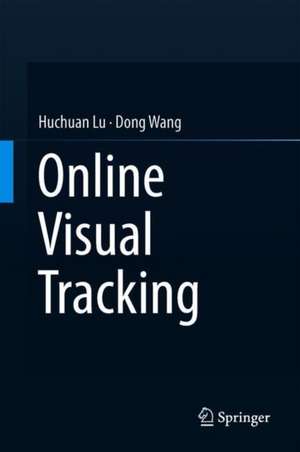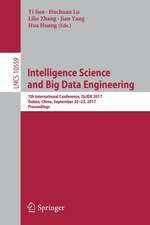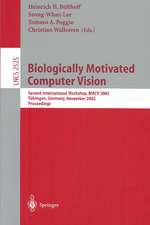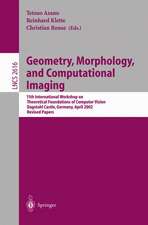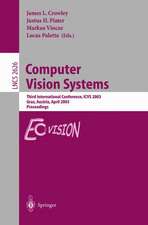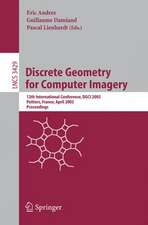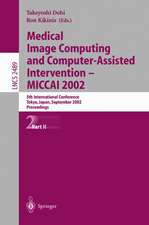Online Visual Tracking
Autor Huchuan Lu, Dong Wangen Limba Engleză Hardback – 14 iun 2019
Chapters 1 to 6 introduce readers to tracking methods based on online learning algorithms, including sparse representation, dictionary learning, hashing codes, local model, and model fusion. In Chapter 7, visual tracking is formulated as a foreground/background segmentation problem, and tracking methods based on superpixels and end-to-end deep networks are presented. In turn, Chapters 8 and 9 introduce the cutting-edge tracking methods based on correlation filter and deep learning. Chapter 10 summarizes the book and points out potential future research directions for visual tracking.
The book is self-contained and suited for all researchers, professionals and postgraduate students working in the fields of computer vision, pattern recognition, and machine learning. It will help these readers grasp the insights provided by cutting-edge research, and benefit from the practical techniques available for designing effective visual tracking algorithms. Further, the source codes or results of most algorithms in the book are provided at an accompanying website.
Preț: 643.97 lei
Preț vechi: 804.95 lei
-20% Nou
Puncte Express: 966
Preț estimativ în valută:
123.24€ • 133.82$ • 103.52£
123.24€ • 133.82$ • 103.52£
Carte tipărită la comandă
Livrare economică 22 aprilie-06 mai
Preluare comenzi: 021 569.72.76
Specificații
ISBN-13: 9789811304682
ISBN-10: 9811304688
Pagini: 136
Ilustrații: X, 128 p. 115 illus., 44 illus. in color.
Dimensiuni: 155 x 235 x 11 mm
Greutate: 0.38 kg
Ediția:1st ed. 2019
Editura: Springer Nature Singapore
Colecția Springer
Locul publicării:Singapore, Singapore
ISBN-10: 9811304688
Pagini: 136
Ilustrații: X, 128 p. 115 illus., 44 illus. in color.
Dimensiuni: 155 x 235 x 11 mm
Greutate: 0.38 kg
Ediția:1st ed. 2019
Editura: Springer Nature Singapore
Colecția Springer
Locul publicării:Singapore, Singapore
Cuprins
1. Introduction to visual tracking.- 2. Visual Tracking based on Sparse Representation.- 3. Visual Tracking based on Local Model.- 4. Visual Tracking based on Model Fusion.- 5. Tracking by Segmentation.- 6. Correlation Tracking.- 7. Visual Tracking based on Deep Learning.- 8. Conclusions and Future Work.
Notă biografică
Huchuan Lu received his MS in Signal and Information Processing and his PhD in System Engineering from Dalian University of Technology (DUT), Dalian, China, in 1998 and 2008, respectively. He joined the DUT faculty in 1998 and currently is a Full Professor at the School of Information and Communication Engineering. His current research interests include computer vision and pattern recognition with a focus on visual tracking, saliency detection, and segmentation. He is a member of the ACM and an Associate Editor of the IEEE Transactions on Cybernetics.Dong Wang received his BE in Electronic Information Engineering and his PhD in Signal and Information Processing from Dalian University of Technology (DUT), China, in 2008 and 2013, respectively. He is currently a Faculty Member with the School of Information and Communication Engineering, DUT. His current research interests include facial recognition, interactive image segmentation, and object tracking.
Textul de pe ultima copertă
This book presents the state of the art in online visual tracking, including the motivations, practical algorithms, and experimental evaluations. Visual tracking remains a highly active area of research in Computer Vision and the performance under complex scenarios has substantially improved, driven by the high demand in connection with real-world applications and the recent advances in machine learning. A large variety of new algorithms have been proposed in the literature over the last two decades, with mixed success.
Chapters 1 to 6 introduce readers to tracking methods based on online learning algorithms, including sparse representation, dictionary learning, hashing codes, local model, and model fusion. In Chapter 7, visual tracking is formulated as a foreground/background segmentation problem, and tracking methods based on superpixels and end-to-end deep networks are presented. In turn, Chapters 8 and 9 introduce the cutting-edge tracking methods based on correlation filter and deep learning. Chapter 10 summarizes the book and points out potential future research directions for visual tracking.
The book is self-contained and suited for all researchers, professionals and postgraduate students working in the fields of computer vision, pattern recognition, and machine learning. It will help these readers grasp the insights provided by cutting-edge research, and benefit from the practical techniques available for designing effective visual tracking algorithms. Further, the source codes or results of most algorithms in the book are provided at an accompanying website.
Chapters 1 to 6 introduce readers to tracking methods based on online learning algorithms, including sparse representation, dictionary learning, hashing codes, local model, and model fusion. In Chapter 7, visual tracking is formulated as a foreground/background segmentation problem, and tracking methods based on superpixels and end-to-end deep networks are presented. In turn, Chapters 8 and 9 introduce the cutting-edge tracking methods based on correlation filter and deep learning. Chapter 10 summarizes the book and points out potential future research directions for visual tracking.
The book is self-contained and suited for all researchers, professionals and postgraduate students working in the fields of computer vision, pattern recognition, and machine learning. It will help these readers grasp the insights provided by cutting-edge research, and benefit from the practical techniques available for designing effective visual tracking algorithms. Further, the source codes or results of most algorithms in the book are provided at an accompanying website.
Caracteristici
Comprehensively presents the state of the art in online visual tracking Covers both theory and practice aspects of the topic, addressing seminal research ideas and also approaching the technology from a practical point of view Supplies sample codes at an accompanying website
